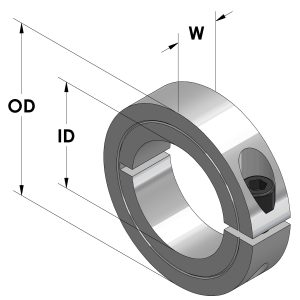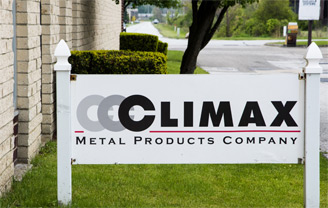What is a Shaft Collar?
Shaft Collars have extremely diverse applications. Shaft collars are used on applications from holding up a flag on a flag pole, to positioning devices on medical equipment to the more common industrial applications of holding other shaft components such as bearings, sprockets and pulleys in place. In general, shaft collar applications fall into one of three broad categories:
Positioners: Locate or position components on a shaft.
Spacers: Keep components “spaced” apart.
Limiters: Limit the movement of a shaft such as in a reciprocating application.
For more information check out the following: Shaft Collars Infographic.
What type of shaft collars does Climax manufacture?
Climax manufactures set screw collars and clamping collars. We also customize dimensions, add keyways, offer balanced collars, provide specialized plating, and manufacture from a variety of materials.
Set Screw Collars are the most commonly used and cost effective shaft collars. The holding power of a set screw collar is provided by the impingement of the screw into the shaft. Lightweight styles are available (more…)
What materials are used in manufacturing Climax shaft collars?
Steel Collars are the most commonly used and manufactured. The exact type of steel used varies depending on the machine process but generally low-carbon steel is used, including materials such as 1215, 1045, and 1026.
Stainless Steel Collars are used primarily in applications (more…)
What finishes does Climax offer on shaft collars?
Black oxide finish on our mild steel collars is formulated as part of the total performance of the collar. The black oxide affects the anti-stick-slip characteristics and helps keep the torque rating of the screw within its design parameters. Black oxide also has corrosion (more…)
What is the industry standard for a shaft collar?

Why does a one-piece collar have a relief cut?
The relief cut removes some of the rigidity of a one-piece clamping collar to allow the screws to clamp more evenly and securely. A relief cut is important only on smaller bore collars because of the ratio of the screw to the collar material – the screw provides much of the clamp load. Climax puts a relief cut in collars with a 1 ½” bore or smaller. Relief cuts can be found on metric collars 19 mm and smaller and on our threaded collars sizes under 1 ¾-16 in.
Why do clamping collars have face grooves?
The face groove on clamping collars indicates the face that should be placed against a bearing or other component requiring a perpendicular to bore orientation. For two-piece clamping collars, the face groove also helps keep the two halves of the collar properly oriented during installation.
Can a Climax shaft collar be welded?
Shaft collars can be welded with some exceptions. Mild steel and stainless steel materials contain sulfur and other additives which allow for welding. However, the lowest possible current and adequate ventilation should be employed. Be sure to remove screws before welding. However, in no cases should collars with zinc plating be welded. The welding process on a zinc plated product will produce noxious fumes. Welding can be done safely on a black oxide finished product. Extreme caution is recommended when welding imported collars because of the inconsistency of the material and finishes.
What is axial holding power?
The primary purpose of a shaft collar is to resist an axial load. That is to hold itself in place despite pressure along the axis of a shaft. The axial holding power is primarily a function of screw size and applied torque. However, other factors such as presence of oil, temperature, and the finish and hardness of the shaft can impact the holding power.
What is your axial load capability?
Collar resistance to axial motion on the shaft is primarily a function of screw size. The tables indicate maximum static load that a collar will support without slippage. It is based on screws at full recommended seating torque, and for set screw collars, shaft hardness not exceeding Rockwell C35. (more…)










